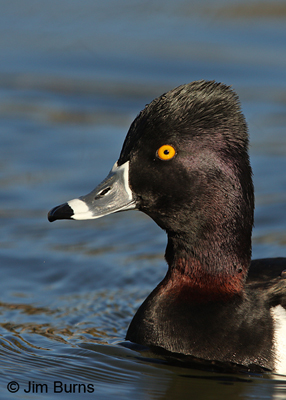
Many of our birds, though, are named, thankfully, for an outstanding physical characteristic, and one would logically presume that feature would be the bird’s most prominent one. Logic, however, does not often prevail in many cases. Ring-billed Gull? Sure, that’s a good one. At least by its first winter this species’ most obvious field mark is, indeed, the broad black ring on its bill. So . . . we’re on a roll here, right.
Well, maybe not so much. How about one of the Valley’s most common wintering ducks? The one the National Geo field guide says, in the opening sentence of its species account, has a “bold white ring near the tip of bill.” If you’re a beginning birder and you’re matching the duck in the pond with the image in the field guide, you’re thinking “I got this one—Ring-billed Duck,” right? Oh, no wait, the guide book says “Ring-necked Duck! Is that a typo? In a field guide? What am I missing here?
Well, if the light’s not just right, you’re obviously missing the ring on the Ring-necked Duck’s neck. If you’re confused, get used to it because the ornithological powers-that-be aren’t going to back up any time soon and apply logic to all our common bird names. It’s understood, at least among identification experts and bird photographers, that photographs often lie. Check out the frame that opens this column. That’s a Ring-necked Duck, but if you can see a ring around its neck, you have a very active imagination. I’d just like to know what the scientific describer of Ring-necked Duck was smoking when he first laid eyes on his prize.
Ring-necked Duck is a striking bird which immediately catches the eye, even at some distance, because of the smashing dark/light contrast of its body feathers. Next, the eye goes quickly to the tri-colored bill with its even more obvious, clean and contrasting pattern. Black, white, silver. There are no greater contrasts anywhere on the color wheel. The only other physical feature which may stand out on Ring-neckeds is the peaked crown, but we all know this prominence is dependent on the mood and movement of the individual bird.
I was years into serious birding before I realized that, yes, you can actually see the ring on the Ring-necked’s neck if you catch it in a certain light. I own six field guides, and only one of them depicts any hint of that ring, and it is only a hint in that one. So, beginners beware. What you see may not be in the name. It would sure be easier starting out if it were.
